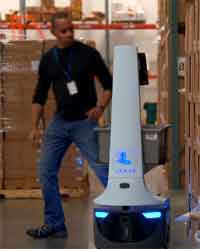There is certainly high interest in mobile automation in material handling systems, especially in distribution operations.
A focus group within MHI, an association of providers of materials handling systems of all sorts, supports applications for automatic guided vehicle systems.
Supply Chain Digest Says... |
|
|
According to the MHI web page for the Mobile Automation Group (MAG), mobile automation technology includes both Automatic Guided Vehicles (AGVs) and Autonomous Mobile Robots (AMRs). What is the difference between these two styles of mobile automation?
The MAG says:
• Most AGVs follow predefined paths, although there may be areas of the plant or warehouse where they have more freedom.
• AMRs can determine their own path, although they will attempt to follow suggested paths if they exist.
In support of its goal of increasing adoption of mobile automation solutions, the MAG recently published a blog on the “Top Misconceptions of Mobile Automation.”
Here are the highlights:
Myth #1: Mobile Automation Vehicles (MAVs) require invasive and expensive infrastructure
The truth is MAVs can easily integrate into existing facilities with minimal changes, MAG says.
It adds that mobile automation solutions are usually easy to install - or in some cases, require no installation at all.
Many MAV manufacturers also offer guidance and support throughout the entire integration process to ensure a smooth transition.
Myth #2: MAVs won’t integrate with current software
MAG says MAVs integrate easily with any standard ERP, WMS, or host system, with most providers offering “seamless integration.”
SCDigest will just note there is rarely such a thing as seamless integration.
MAG adds that in some cases, MAVs can even start adding value without the need for integration. This means your business can begin seeing the benefits of automation immediately.
MAG also adds that “Integrating MAVs into your warehouse operation is a breeze” – that, SCDigest can say with confidence, is a big overstatement.
Myth #3: Automation is all or nothing
MAG says that mobile automation for warehouses is often thought to be an all-or-nothing proposition, that you can either automate the entire warehouse or not automate it at all. “This is a myth,” MAG says.
(See More Below)
|
CATEGORY SPONSOR: SOFTEON |
|
|
| |
|
|
 MAG notes that there are many different ways to add MAVs to a warehouse. You can automate specific tasks, or you can automate the entire process from start to finish. MAVs are also ideal for testing or scaling automation. For instance, starting with one or two machines and expanding later on. They can be added in phases, including alterations to respond to demand. You can also use a combination of these methods, depending on your needs and the size of your warehouse. MAG notes that there are many different ways to add MAVs to a warehouse. You can automate specific tasks, or you can automate the entire process from start to finish. MAVs are also ideal for testing or scaling automation. For instance, starting with one or two machines and expanding later on. They can be added in phases, including alterations to respond to demand. You can also use a combination of these methods, depending on your needs and the size of your warehouse.
This flexibility often makes MAVs an attractive option.
Myth #4: MAVs won’t work for your specific application
MAG notes the MAVs come in all shapes and sizes and are designed for different purposes. Some are small and nimble, perfect for maneuvering through tight spaces or between racks of products. Others are larger and more robust, built to carry heavier loads over longer distances. No matter your application or business, there is likely a MAV that can help, MAG believes.
MAG adds that one specific type of MAV with a special navigation system is the AMR. AMRs use internal facility maps to efficiently navigate based on current conditions. This enables them to function flexibly alongside human workers, adapting to changes in the layout or product mix on the fly.
MAVs are extremely varied and not all fork based. Regardless of your end product or warehouse layout, there is a MAV that could be a fit.
The blog concludes by stating that “Mobile automation has revolutionized the way warehouses operate by unlocking significant operational efficiencies, enabling workers to complete tasks faster and more accurately than ever before.
MAG adds that mobile automation has other benefits as well, including reducing injuries, errors, and product damage. It also lowers operating costs by enabling multi-shift and 24/7 operations.
Do you have any thoughts on these "myths"? Let us know your thoughts at the Feedback button below (email) or in the Feedback section.
|